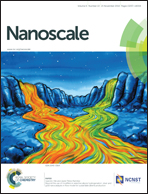Novel cookie-with-chocolate carbon dots displaying extremely acidophilic high luminescence†
Abstract
A fluorescent carbon dot with a cookie-with-chocolate film structure (about 5 × 5 μm2) showed a high fluorescence quantum yield (61.12%) at low pH. It was hydrothermally synthesized from L-serine and L-tryptophan. The formation mechanism of the film with carbon dots (CDs) was investigated. The film structure was formed by hydrogen bonding and π–π stacking interactions between aromatic rings. The strong blue fluorescence of the CDs increased under strong acidic conditions owing to the changes in the N-groups. These cookie-like CDs are attractive for their potential use as effective fluorescent probes for the sensitive detection of aqueous H+ and Fe3+.


 Please wait while we load your content...
Please wait while we load your content...